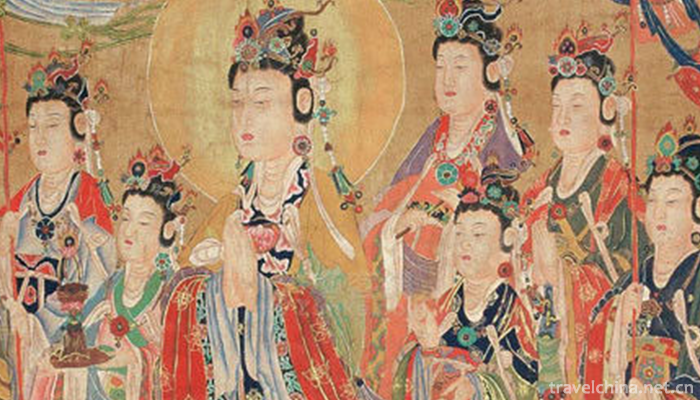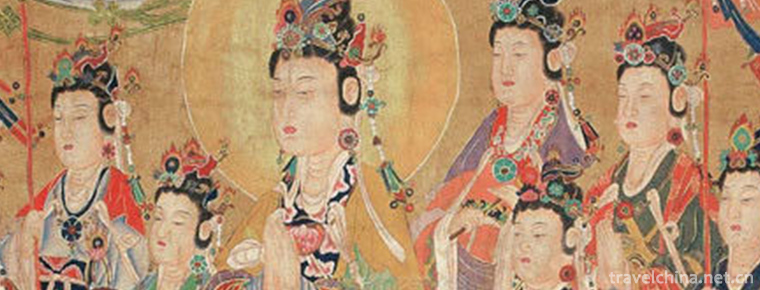Surface painting
Surface painting
Water and land painting Festival is a traditional religious painting. Originated in the Three Kingdoms Period, Buddhist monasteries prevailing from the Jin Dynasty to the Yuan, Ming and Qing Dynasties are an important Buddhist event held for the purpose of overtaking the dead and popularizing all the ghosts and gods on land and water. It is a folk cultural phenomenon that emerges and develops under the background of "the unity of the three religions". Land and water painting is a religious figure painting worshipped by the Land and Water Law Society.
On November 11, 2014, land and water paintings were approved by the State Council and listed in the fourth batch of national intangible cultural heritage list.
Historical Origin
Land and water law clubs, also known as "land and water fairs", "water and land fasts", "charity clubs" horse "charity clubs" and "seven fasts", are abbreviated as "land and water clubs", commonly known as "land and water clubs". They are all called "Saint Fan Shui Lu Pudu Ramadan Winning Club". They refer to the gathering of rescuers and rescued persons in the opening of law clubs. All participants can receive both excessive application of law and food and universal acceptance. Bitterness is a kind of grand law meeting which sets up a fasting to worship Buddha and gods to recommend the spirits and ghosts beyond the dead. It is the most solemn, grandest and longest ritual in Chinese religious activities. Waterfront painting emerged with the emergence of the Land and Water Law Society. It is a religious painting hanging in monasteries or private holding of the Land and Water Law Society. It is one of the indispensable sacred objects for holding the Land and Water Law Society. There is a cloud in a model vow of the Mid-Tang Dynasty unearthed from Tibetan ketone in Dunhuang at the end of Qing Dynasty: "So on this day, the courtyards were swept and the pavilions were strictly decorated. Buddhist monks were invited to set up their fasts to pursue their blessings..." At that time, on the "Dao Chang", there were various Buddhist banner wallcharts with religious figures as the theme, that is, the early land and water paintings. According to the existing literature, the early images of the Water and Land Law Society began in the late Tang and Five Dynasties, and gradually formed a system. Legend has it that the Southern Water and Land Society of Pingyang City, Shanxi Province, was named after 120 water and land painting axes of Wu Daozi (685-758) in the Tang Dynasty. Volume 23 of The Idol Talk in Chibei also has relevant records. Although this set of water and land paintings is the so-called works of Wu Daozi in the Tang Dynasty, in fact, it is not based on legends.
Through the spread and development of the Five Dynasties and the Song Dynasty, land and water painting has gradually formed into a complete set of scale. At that time, there were water and land halls and a complete set of water and land painting scrolls in Buddhist temples and Taoist concepts. For example, the main hall of Yanshan Temple in Fanshi Jin Dynasty in Shanxi Province was originally the water and land hall. The murals in the hall were painted by Wang Kui and Wang Dao in the third year of Zhenglong (1158). Unfortunately, the murals in the hall have been destroyed. During the Yuan and Ming Dynasties, the water and land paintings hanging on the waterway and land course were basically stereotyped. One hundred and twenty water and land paintings were painted in the West Water and Land Law Society built by the general monastery. As many as 200 axes of land and water paintings were used in the land and Water Law Societies built by the imperial court. These works are mostly painted by the masters of folk Taoist interpretation. They are precise and well-organized. Their contents include all the gods worshipped by the people. Their hanging lengths depend on the scale of the events. In addition, in this period, besides the complete set of scroll water and land portraits, special water and land halls appeared in Buddhist temples and Taoist concepts, and water and land frescoes with complete composition were painted.
Most of the land and water paintings preserved in the 21st century were painted in the Ming and Qing dynasties, especially in the temples of Shanxi and Hebei provinces. Although these temples were built in different times, most of them were painted after the Song and Yuan dynasties. Most of the existing water and land paintings in Shanxi are Ming Dynasty works. For example, the waist hall murals of Jishan Qinglong Temple (Shuilu Hall) are well preserved. Based on the investigation of architecture, murals style and relevant years, the murals of the whole hall should be completed in the early Ming Dynasty. The four-wall paintings of the temple used to depict immortals and ghosts, emperors and concubines, as well as Yincao prefecture, which advocated "retribution for cause and effect", suggesting that people should convert to religion to avoid suffering. The Ming murals of Dinglin Temple, Hunyuan Yongan Temple and Lingshi Zishou Temple in southern Shanxi also had merits of water and land. They were magnificent and full of figures, and were important works for studying the content and art of water and land paintings.
Inheritance Significance
Water and land paintings provide information for the study of Buddhist history. From its origin to its prosperity, land and water law societies have infiltrated many contents of Taoism, Confucianism and folk gods, from which we can learn the course of the Sinicization of Buddhism. In the early days of the founding of the People's Republic since the Tang and Song Dynasties, when the emperors ascended the throne, they built land and water law societies to recommend the dead of loyal ministers, martyrs and refugees, in order to appease the people's hearts and pray for social peace; and land and water paintings are also a historical study of the integration of Confucia Provide information. After Sui, Tang and Yuan dynasties, Confucianism, Buddhism and Taoism merged, but we mostly studied them from abstract literary materials. Water and land paintings provided us with very specific image data, from which we can see that the three religions of Confucianism, Buddhism and Taoism, gods, Buddha and immortals, organized in a mythological system in an orderly manner according to their levels and functions, are neither contradictory nor reasonable. Faith folklore research provides information. Buddha, gods and immortals in land and water paintings are worshipped by the Chinese people. From land and water paintings, we can study the Chinese people's belief in folk customs and belief psychology. Ming Dynasty's land and water paintings are more standardized and secular. In the paintings, not only the skills of cheap team paintings and landscape paintings, but also the contents of many folk customs can be seen. The pictures include social customs, which provide vivid and intuitive image data for modern people to study history; water and land paintings provide information for the study of ancient Chinese costumes; water and land paintings describe the style and color of the costumes of the characters at that time in detail. In addition to the portraits of Buddha, gods and immortals, painters in ancient times depicted them according to pink books. The common costumes of ancient sages and sages were painted according to the costume system of the society at that time, which provided specific images for the study of costumes in ancient China. The costumes in modern Chinese drama are very similar to those in land and water paintings, and also can provide information for the study of the history of Chinese drama.
Master of Water and Land Painting
With the development of waterway and land painting, waterway and land painting has become a kind of Chinese religious painting. The founder of Buddhist painting is said to be Cao Fuxing, a famous painter in the Three Kingdoms Period. Later, many famous painters painted murals of various religious villages for monasteries. Gu Kaizhi, a famous artist in the Eastern Jin Dynasty, is not only good at drawing characters. Landscape, and the religious paintings are also outstanding in the painting world. There is a well-known story about the Vimo portrait he painted for the Wacoffin Temple in Luoyang. According to legend, he tried painting for a month behind closed doors, and opened an account for people to appreciate. The image of Vimo theory is clear and elegant. The image of "Lighting One Temple" and even "the giver bites the throat" instantly "makes the bait millions".


-
1.Mao tofu Fried bean curd
Mao tofu Fried bean curd is a famous traditional dish in Huizhou, Anhui Province, and is well known for its vegetarian delicacies at home and abroad.
Time 2018-11-27 -
2.Laojunshan Jiguandong Tourist Area
Jiguan Cave is located in Luanchuan County, Luoyang City, Henan Province, three kilometers west of the county seat. It is located on the half-hillside of Jiguan Mountain
Time 2018-12-09 -
3.Guangzhou Changlong Tourist ResortTime 2018-12-12
-
4.Chinese Sun Valley
Located in the development zone of Dezhou, Sun Valley of China is the largest base of research, development, testing, production, education and tourism of renewable energy in the world.
Time 2019-01-18 -
5.Mixed congee
Babao, also known as Laba porridge, Buddha porridge, is a traditional Chinese Festival food. It is a kind of porridge boiled with various ingredients on Laba Festival.
Time 2019-03-27 -
6.Ghost Millet Guiguzi Legend
Guiguzi Birthplace Site is located in Salt Food Village, Xiangcaiying Township, Linzhang County. It covers an area of 76 Mu and has a construction area of 26 mu.
Time 2019-05-01 -
7.Ham making skills
Xuanwei ham production technology is a traditional handicraft in Xuanwei area of Yunnan Province. Xuanwei ham is a famous local traditional specialty.
Time 2019-05-05 -
8.Pucheng Folk Song
Shaanxi folk song is the continuous interaction, integration, creation, development and transmission of various artistic forms among the working people in the production practice and social practice o
Time 2019-06-09 -
9.Brewing Techniques of Qingxu Old Vinegar
The brewing process of Qingxu aged vinegar is complex. After the main steps of ingredients, steaming, manual turning of solid acetic acid, high temperature fumigation, high density leaching, aging and
Time 2019-06-11 -
10.Quyang stone carving
Quyang stone carving is an important part of folk art in Quyang County, Hebei Province. Since the Western Han Dynasty, Quyang stone workers have used marble to carve steles and other objects. Quyang s
Time 2019-06-11 -
11.Brown Fan Dance
On the day of the grand Brown fan dance festival, adult men gather in groups on a square with their own delicacies and rice wine every day, and hold a large-scale Brown fan dance activities by arrangi
Time 2019-08-16 -
12.Administrative division of Deyang
Deyang City has 6 county-level administrative divisions (Municipal District 2, county-level city 3, county-1), and 84 township level administrative divisions (street 13, town 67, township 4). It covers an area of 5911 square kilometers and has a population of 3.92 million.
Time 2020-12-14